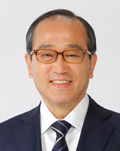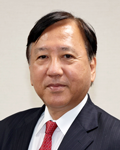About HPCF
| Outline of Purpose |
|
Based on Hiroshima's A-bomb experience, collaborating with peace research institutions and related organizations in Japan and abroad, this Foundation seeks to convey the facts about the bombing and contribute to the dissemination of thought promoting peace and international understanding/cooperation. The overall goal is to contribute to world peace and human happiness.
|
| President and Chairperson |
 President / Kazumi MATSUI
 Chairperson / Takehiro KAGAWA
|
| Charter |
| History |
| October 1967 | Established as a bureau within the City of Hiroshima government, called the Hiroshima Peace Culture Center. |
| April 1976 | The Hiroshima Peace Culture Foundation is established. |
| April 1978 | Begins providing study seminars to students on school excursions (showing A-bomb documentary films and arranging talks by A-bomb survivors). |
| May 1978 | The United Nations holds the first Hiroshima-Nagasaki A-bomb Photo Exhibition. |
| January 1983 | Issues a call to 72 cities in 23 countries in the world to join the Program to Promote Solidarity of Cities toward the Total Abolition of Nuclear Weapons. |
| September 1983 |
Organizes the Atomic Bomb Witness organization, a survivors' organization within the Foundation. UN Disarmament Fellows visit Hiroshima for the first time (22 subsequent visits). |
| August 1985 | First World Conference of Mayors for Peace through Inter-city Solidarity is held in Hiroshima and Nagasaki (5 subsequent conferences). |
| October 1985 |
Holds first Gathering of Hiroshima Citizens for Peace, to commemorate the 40th anniversary of the atomic bombing and UN Disarmament Week (9 subsequent gatherings). Publishes Peace Encyclopedia. |
| May 1986 | Begins shooting first atomic bomb witness videos. |
| August 1986 | Holds '86 Peace Summit in Hiroshima. (Has since held the International Symposium for Peace in Hiroshima, with Nagasaki as an alternate location.) |
| October 1987 | Organizes an atomic bomb witness exchange gathering. |
| November 1988 | Sends the first delegation to China to begin a relationship with the Chinese People's Association for Peace and Disarmament. |
| March 1990 | Completes the Atomic bomb documentary film Hiroshima: A Mother's Prayer. |
| June 1991 | Holds the United Nations and Disarmament Symposium (5 subsequent symposia). |
| June 1992 | Holds the first UN Conference on Disarmament Issues in Hiroshima. |
| March 1993 | Settles on a plan to construct the Peace Database. |
| August 1995 | Operates the Peace Database (static image system). |
| April 1998 |
Combines with the Hiroshima International Relations Organization to become the new Hiroshima Peace Culture Foundation. Entrusted by the City of Hiroshima with managing and operating the Hiroshima Peace Memorial Museum and the International Conference Center Hiroshima. |
| April 1999 | Begins the Hiroshima Peace Volunteer program. |
| December 1999 | Uploads the Peace Database on the Internet. |
| April 2001 |
The Hiroshima City International House opens. Entrusted by the City of Hiroshima with managing and operating the International House. |
| June 2002 | Begins Hiroshima Peace Forum. |
| August 2002 |
The Hiroshima National Peace Memorial Hall for the Atomic Bomb Victims opens in Peace Memorial Park in Hiroshima City. Entrusted by the Ministry of Health, Labour, and Welfare with managing and operating the Memorial Hall. |
| April 2006 | Appointed as the administrator by the City of Hiroshima to manage and operate the Hiroshima Peace Memorial Museum, the International Conference Center Hiroshima, the Hiroshima City International House. |
| July 2006 | The Hiroshima Peace Memorial Museum becomes the first building after the war to be designated a national important cultural property. |
| January 2007 | Formulates the Renewal Plan for the Hiroshima Peace Memorial Museum. |
| February 2007 | Peace Memorial Park becomes the first park built after the war to be designated a place of extraordinary scenic beauty. |
| September 2007 - March 2009 |
Begins A-bomb exhibitions in the United States. Within 2 years, ending in March of 2009, 113 cities in 48 states had hosted A-bomb exhibitions, including the capital, Washington, D.C. |
| July 2010 | Formulates the Basic Plan for the Hiroshima Peace Memorial Museum's Displays. |
| April 2011 | This foundation was authorized as the public interest incorporated foundation by the Japanese government. |
| November 2011 | Opens the Exhibition about the Atomic Bombings and Disarmament in the United Nations Office at Geneva. |
| November 2012 | Opens the Schmoe House, an exhibition facility affiliated with the Hiroshima Peace Memorial Museum. |
| March 2014 | Partially begins the complete renovation work of Hiroshima Peace Memorial Museum. |
| March 2014 | Expiration of the Administration Entrustment Agreement of Hiroshima City International House. |
| April 2017 |
The East Building of the Hiroshima Peace Memorial Museum reopens. The Main Building is closed for renovations and reorganization of the permanent exhibits. |
| April 2019 | The Main Building of the Hiroshima Peace Memorial Museum reopens. |
As a result of abolishing the Hiroshima Peace Memorial Hall, which opened in 1955, the new Hiroshima Peace Memorial Museum, combining the former Hiroshima Peace Memorial Museum (now, the Main Building) and the East Building, reopened in June 1994.
Exhibits in the East Building convey the history of Hiroshima before and after the atomic bombing and the nuclear age through models, photos, panels, etc. The East Building has the Peace Memorial Hall, used for study seminars, meeting rooms, the Library, the Museum Shop, and more. The Main Building conveys the events of August 6, 1945, with belongings of those who died, A-bomb artifacts, and more. Opened in 1989. Facilities include the Phoenix Hall with 1,504 seats, four large and small conference rooms for lectures, meetings, banquets, etc. The Center also has the International Exchange Lounge.
Exhibits in the East Building convey the history of Hiroshima before and after the atomic bombing and the nuclear age through models, photos, panels, etc. The East Building has the Peace Memorial Hall, used for study seminars, meeting rooms, the Library, the Museum Shop, and more. The Main Building conveys the events of August 6, 1945, with belongings of those who died, A-bomb artifacts, and more. Opened in 1989. Facilities include the Phoenix Hall with 1,504 seats, four large and small conference rooms for lectures, meetings, banquets, etc. The Center also has the International Exchange Lounge.
The national facility opened on August 1, 2002, with the purpose of mourning the victims of the atomic bombing and praying for genuine and lasting peace. It provides a Hall of Remembrance and collects names, photographs and memoirs of atomic bomb victims.
| Main Activities |
|
Main activities (PDF)
|
| Budget (Rough Overview) |
| Fiscal 2025 | nonprofit activity |
profitable enterprises |
corporate accounting |
total | |
| General net worth | Opening balance | ▲16,449 | 71,674 | ▲264,007 | ▲208,782 |
| Recurring revenues | 1,516,964 | 766,986 | 160,181 | 2,444,131 | |
| Recurring expenses | 1,564,061 | 695,756 | 175,639 | 2,435,456 | |
| transfer | 37,670 | ▲58,530 | 20,860 | 0 | |
| Designated net worth | Opening balance | 1,183,470 | 0 | 388,142 | 1,571,612 |
| Increase/Decrease | ▲70,522 | 0 | 1,740 | ▲68,782 | |
| Total net worth closing balance | 1,087,072 | 72,032 | 131,277 | 1,290,381 | |
| * yen in thousands | |||||
| List of Board of Directors / Councilors |
| About Logo |
 Hiroshima Peace Culture Foundation's Logo
In March 1993, we adopted the mark at the left as our foundation's logo from ideas submitted by our staff members.This mark is based on a combination of a lowercase “H”, the first letter of “Hiroshima Peace Culture Foundation” and “P”, the first letter of “Peace”. The image also evokes the currents of Hiroshima's rivers in the hope that a smaller current (Hiroshima Peace Culture Foundation's commitment for peace) will become a great river, and one day an ocean that can link the world as one. |